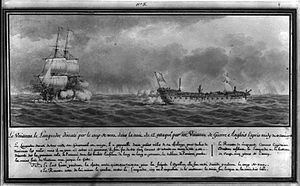Namesake Languedoc In service 17 January 1778 Construction started 1764 Length 60 m Displacement 1.754 million kg Builder Arsenal of Toulon | Laid down 1764 Fate Scuttled in Venice Launched 15 May 1766 Weight 1,754 tons Draft 7.5 m | |
 | ||
Renamed Renamed Anti-fédéraliste
renamed Victoire (July 1794) Class and type Saint-Esprit class ship of the line | ||
The Languedoc was a ship of the line of the French Navy and flagship of Admiral d'Estaing. She was offered to King Louis XV by the Languedoc, as part of the Don des vaisseaux, a national effort to rebuild the navy after the Seven Years' War. She was designed by the naval architect Joseph Coulomb, and funded by a don des vaisseaux donation from the Estates of Languedoc.
Career
Ordered in Toulon, Languedoc took several years to complete due to a lack of timber in the shipyard, already busy building Zélé and Bourgogne, and with the orders of Marseillois and Provence in queue.
In 1776, France decided to intervene in the American War of Independence. Admiral d'Estaing was ordered to bring the fleet to the Americas. He set his flag on the Languedoc, after her upgrade to 90 guns. His 12-ship fleet set sail on the 18 April 1778. The fleet reached New York on 8 July 1778, and Languedoc landed the French chargé d'affaires.
On the 10th of August, the French fleet encountered the English fleets of Admirals Howe and Byron. A tempest broke out, and the Languedoc lost her rigging and steering. The 50-gun Renown raked her, but she was saved by the timely arrival of a French squadron led by Suffren.
The Languedoc took part in the Battle of St. Lucia, an abortive attempt to recapture St Lucia from the British in December 1778. The Languedoc then took part in the conquest of Grenada, in July 1779.
The Languedoc returned to France, where she was refitted. In 1781, she set sail in the fleet of Admiral de Grasse, under captain d'Argelos. She took part in the Battle of the Chesapeake.
At the Battle of the Saintes, the Languedoc was following the flagship Ville de Paris. The French fleet was parted in two, and the Languedoc eventually fled the battle, leaving de Grasse to be captured. The Languedoc then joined with La Pérouse, and reached Brest on the 28 June 1783. Argelos was tried for his conduct at the Saintes and found innocent, de Grasse being found ultimately responsible.
The Languedoc was refitted and upgraded by engineer Jacques-Noël Sané. On the 5 September 1792, she set sail under Admiral de Latouche Tréville. She took part in the campaign off Italy, and was badly damaged in the tempests of December; from 21 to 23, Scipion had to assist. On the 7 February, she took part in the landing of troops in Sardinia.
She sailed back to Toulon and undertook extensive repairs. Toulon fell to the hands of the English and was retaken by the French. The Languedoc, being deemed unusable, was not destroyed when the English left the city. She was renamed Antifédéraliste at the height of Robespierre's power, and renamed again to Victoire at the Thermidorian Reaction.
As Victoire, under captain Savary, she took part in the campaign off Italy, where she confronted Nelson's squadron. She served off Canada in 1796, returned to France, and was deemed too old to take part in the landing in Ireland.
She was used as a floating barracks off Venice, where she had been scuttled.
